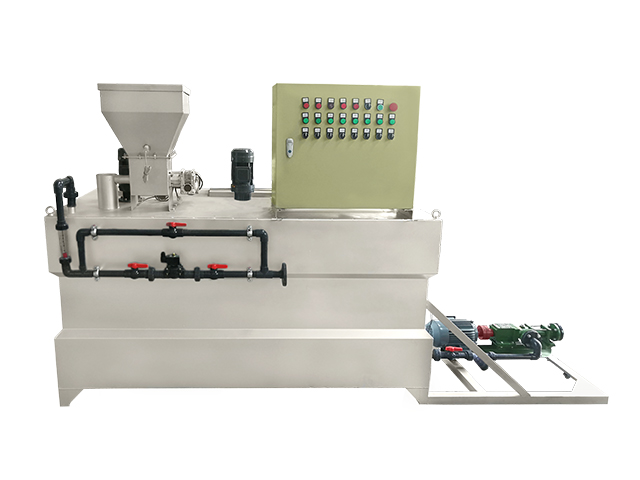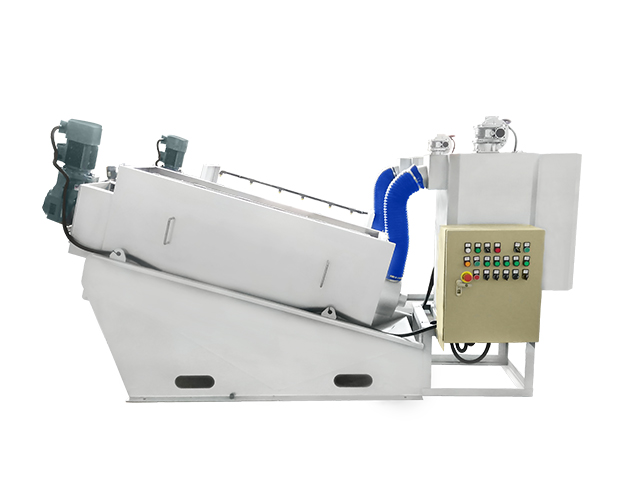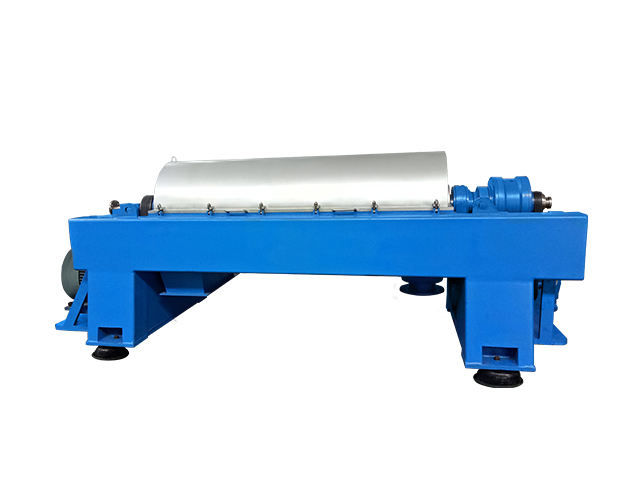
Horizontal decanter centrifuge is an efficient centrifugal separation equipment. Due to the difference of solid-liquid-liquid specific gravity, the solid phase and liquid phase will be separated under the centrifugal force. The whole feeding and separation process is continuous, closed and automatic.
1. Working principle of horizontal decanter centrifuge
Horizontal decanter centrifuge is mainly composed of conical drum, screw pusher, differential system, bearing base, frame, housing, main and auxiliary motor and electrical system. The main motor drives the drum and the secondary motor drives the planetary gear differential, which generates the drum and spiral differential. Under the strong centrifugal force produced by the high-speed rotation, the centrifuge can be separated continuously.
The drum and the screw pusher rotate at a certain differential speed and high speed. The material continuously enters the spiral feeding chamber from the feeding tube, and then accelerates and enters the drum. Under the action of centrifugal force field, the heavier solid phase deposits on the drum wall to form the sediment layer. The solid deposits are continuously pushed to the cone end of the drum by the screw pusher, and discharged from the slag discharge outlet after drying in the drying zone. The lighter liquid phase forms an inner liquid ring, which continuously overflows the drum from the overflow outlet at the large end of the drum and discharges out of the machine through the outlet.
2. Advantages of horizontal decanter centrifuge
It has a wide range of solid particle sizes of 0.005-2mm, and can be separated as usual when the particle size of solid phase is uneven. It has these advantages:
(1) Automatic.
(2) Continuous.
(3) Long-term operation.
(4) Convenient maintenance.
(5) Closes operation.
(6) Large production capacity.
(7) Compact structure.
(8) Small land occupation.
(9) DCS control.
(10) Good wear resistance.
3. Precautions for operation
As a high-speed rotating centrifuge, most of the mechanical faults are in the form of machine vibration. Therefore, as the operator should have a basic understanding of the vibration and dynamic balance of the machine.
(1) The drum and screw must be balanced by dynamic balance.
(2) For machines that are not used for a long time, they should be turned every half a month.
(3) Start the machine slowly to prevent uneven heating.
(4) The operation must be carried out according to the specified startup, shutdown and cleaning procedures.
(5) Pay attention to the vibration and noise of the machine at any time and eliminate it in time.
4. Fault analysis and common solutions
4.1 Machine blockage
The first phenomenon of centrifuge blockage is no slag discharge for a long time. When the discharged clear liquid gradually becomes turbid and dark, and the drum current increases, the drum speed decreases, all these indicate the possibility of internal blockage in the centrifuge.
In this case, do not press the emergency button, the centrifuge is running at high speed and there is no brake device, the emergency button can not provide any help at this time. First of all, we must cut off the feed of the centrifuge immediately. In most cases, the centrifuge can eliminate the blockage by itself, relying on the pushing function of the screw. If it is unable to push the material and remove the blockage, we should immediately reduce the rotating speed of the drum or turn off the drum driving motor, but never turn off the screw motor. After the drum speed has been reduced, the blocked slag may gradually relax and be discharged out of the machine by the screw. For the centrifuges that are really blocked, after the drum stops rotating completely, we should still inject water into the centrifuge and try to restore the operation of the screw. As long as the screw can rotate, the centrifuge is not really blocked, and it is still possible to return to normal. Injecting water into the centrifuge and resuming screw operation are the preferred methods for removing blockage of the centrifuge.
4.2 Machine vibration
Machine vibration is divided into chronic vibration and sudden vibration. Most of the chronic vibration indicates that the centrifuge has been worn, the external parts have worn or fallen off, and the bearing system has been damaged gradually. Sudden vibration often indicates that the internal materials are blocked, and the internal parts have been seriously damaged and fallen off. In most cases, it is necessary to first check whether the slag discharge system fails, which leads to the accumulation of solid slag, and whether the clear liquid pipeline is blocked, which leads to the reverse spread of liquid to the drum.
4.3 High bearing temperature
When the bearing temperature is high, first of all, check whether the amount of grease added to the bearing is too large, whether there is excessive vibration of the centrifuge and abnormal noise of bearing operation. At the same time, we should observe the color of bearing waste grease. The normal color of water grease should be light gray. If the color of waste bearing grease is black, rusty yellow or other abnormal color, it means that the bearing may be damaged, and the bearing should be replaced in advance.
With regard to the noise of bearing operation, not all the noises indicate that there is something wrong with the machine. It is necessary to pay attention to distinguish a kind of normal “baffle ring” sharp noise. It is a grease lubricated friction part in the bearing. When the centrifuge runs normally, it will make a specific sharp sound. This sound will disappear temporarily and will ring again later after one or two greasing operations. This kind of judgment depends on observations at ordinary times and continuous accumulation of experience.
4.4 Manual turning of drum
The manual turning of drum is an effective method to judge whether there is solid accumulation inside the drum and whether the drum can be started smoothly.
When turn the drum manually, if the drum rotates smoothly, decelerates itself through resistance and stops at a random angle, it means that the drum is normal.
If the drum rotates very heavily, and it will turn back by itself after releasing the hand, and after repeated rotation, the drum almost stops at the same position, it means that there is solid accumulation inside the drum.
In this case, inject water into the centrifuge and start the screw motor. After removing the materials inside the drum, then start the drum motor, so as to avoid violent vibration of the drum.


